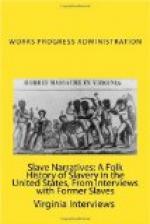Slave Sales, Whippings, Work
“I have heard my folks talk about how they were traded off and how they used to have to work. Their master wouldn’t allow them to whip his hands. No, it was the mistress that wouldn’t allow them to be whipped. They had hot words about that sometimes.
“The slaves had to weave cotton and knit sox. Sometimes they would work all night, weaving cloth, and spinning thread. The spinning would be done first. They would make cloth for all the hands on the place.
“They used to have tanning vats to make shoes with too. Old master didn’t know what it was to buy shoes. Had a man there to make them.
“My father and mother were both field hands. They didn’t weave or spin. My grandmother on my mother’s side did that. They were supposed to pick—the man, four hundred pounds of cotton, and the woman three hundred. And that was gittin’ some cotton. If they didn’t come up to the task, they was took out and give a whipping. The overseer would do the thrashing. The old mistress and master wouldn’t agree on that whipping.
Fun
“The slaves were allowed to get out and have their fun and play and ’musement for so many hours. Outside of those hours, they had to be found in their house. They had to use fiddles. They had dancing just like the boys do now. They had knockin’ and rasslin’ and all such like now.
Church
“So for as serving God was concerned, they had to take a kettle and turn it down bottom upward and then old master couldn’t hear the singing and prayin’. I don’t know just how they turned the kettle to keep the noise from goin’ out. But I heard my father and mother say they did it. The kettle would be on the inside of the cabin, not on the outside.
House, Furniture, Food
“The slaves lived in log houses instead of ones like now with weather-boarding. The two ends duffed in. They always had them so they would hold a nice family. Never had any partitions to make rooms. It was just a straight long house with one window and one door.
“Provisions were weighed out to them. They were allowed four pounds of meat and a peck of meal for each working person. They only provided for the working folks. If I had eight in a family, I would just get the same amount. There was no provisions for children.
“But all the children on the place were given something from the big house. The working folks ate their breakfast before daylight in the log cabin where they lived. They ate their supper at home too. They was allowed to get back home by seven or eight o’clock. The slaves on my place never ate together. I don’t know anything about that kind of feeding.
“They had nurses, old folks that weren’t able to work any longer. All the children would go to the same place to be cared for and the old people would look after them. They wasn’t able to work, you know. They fed the children during the day.




